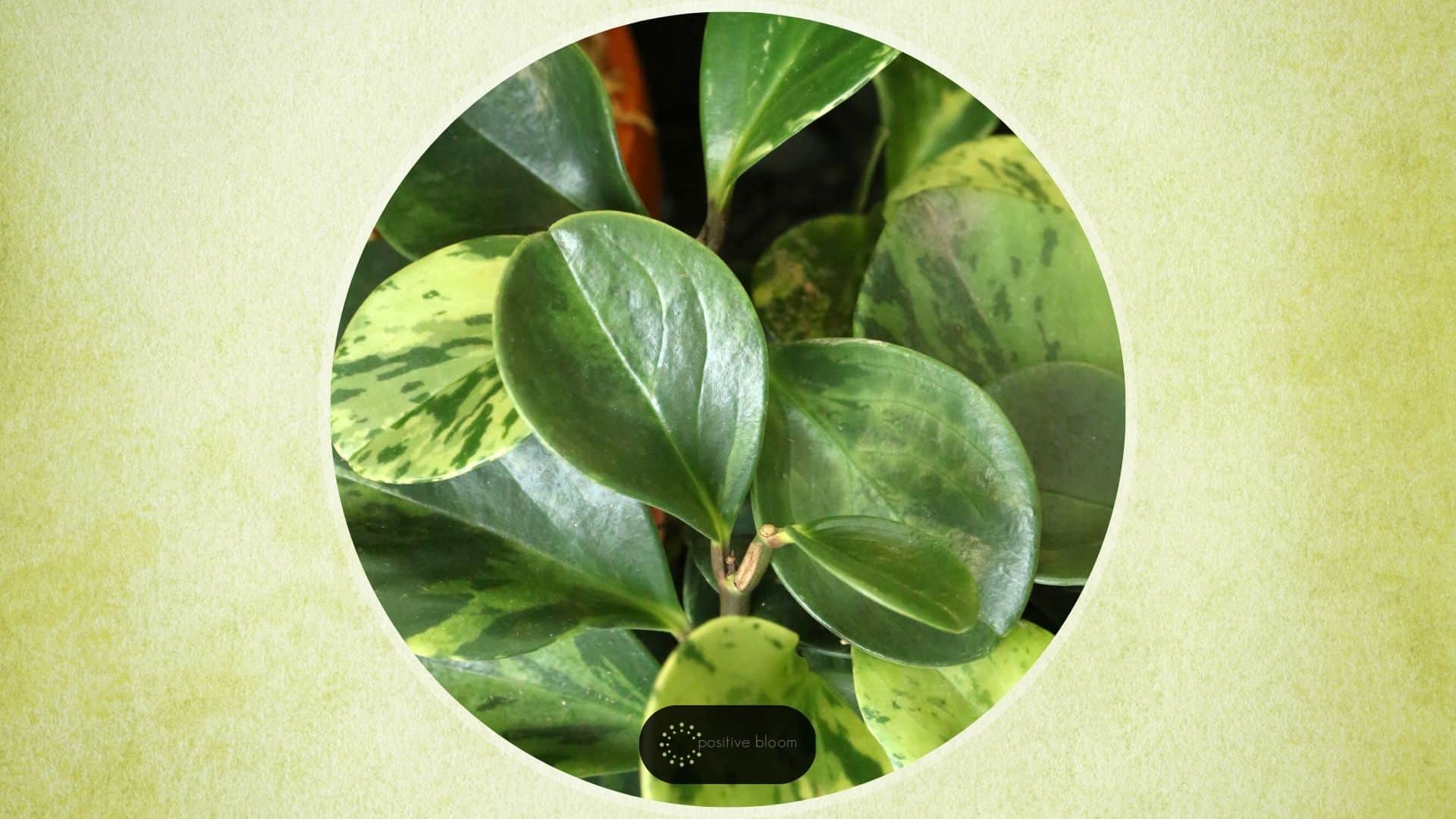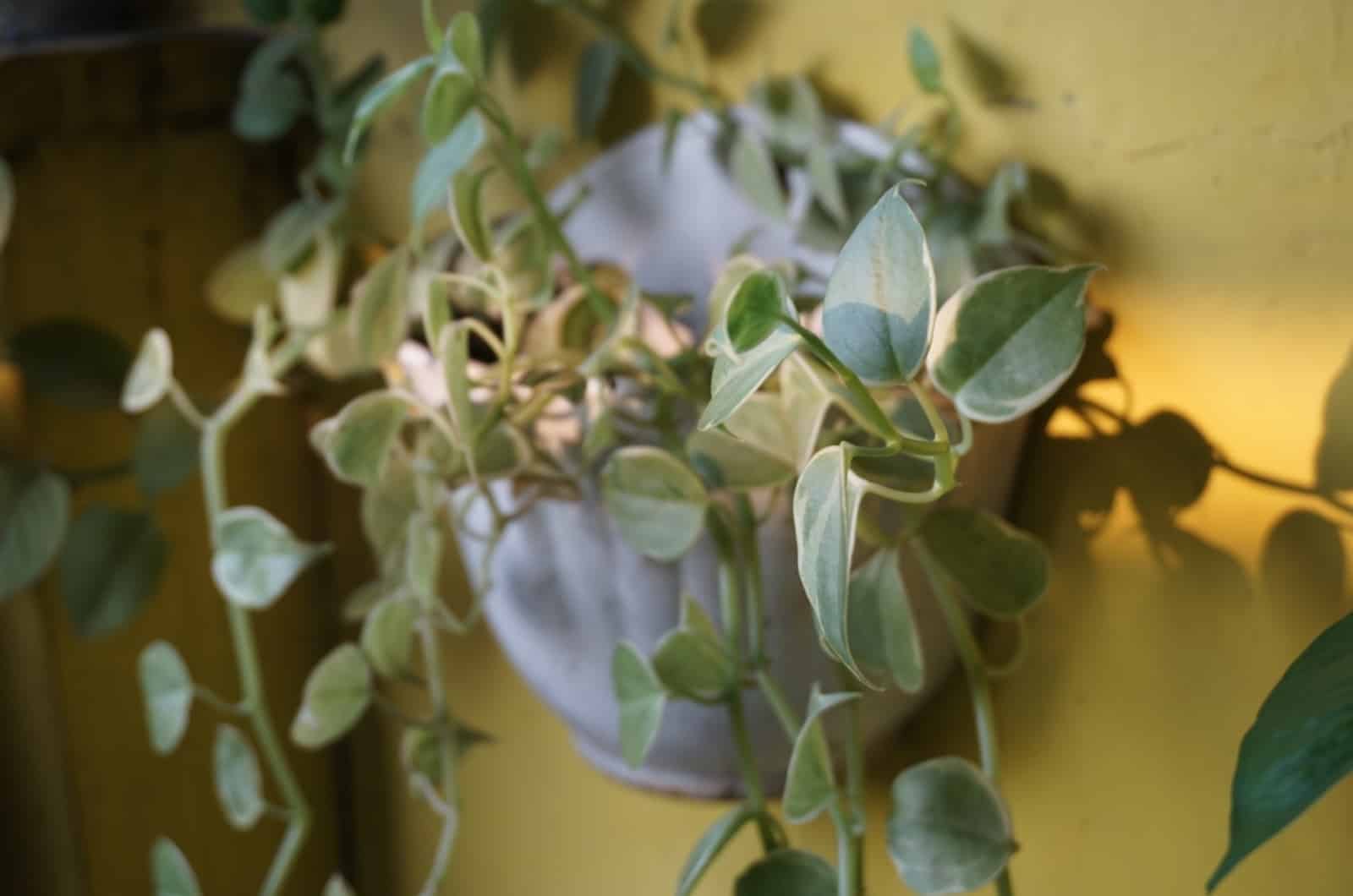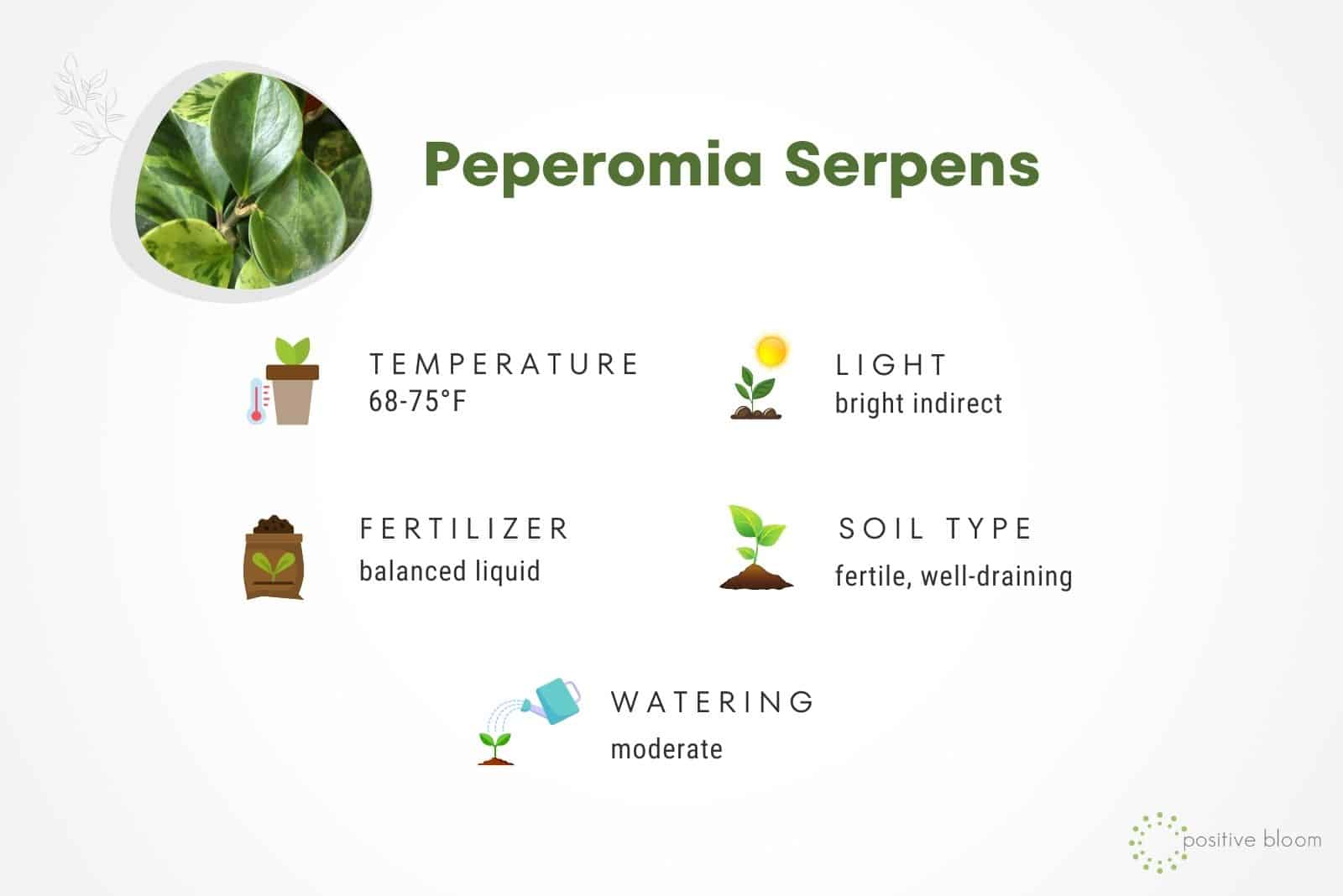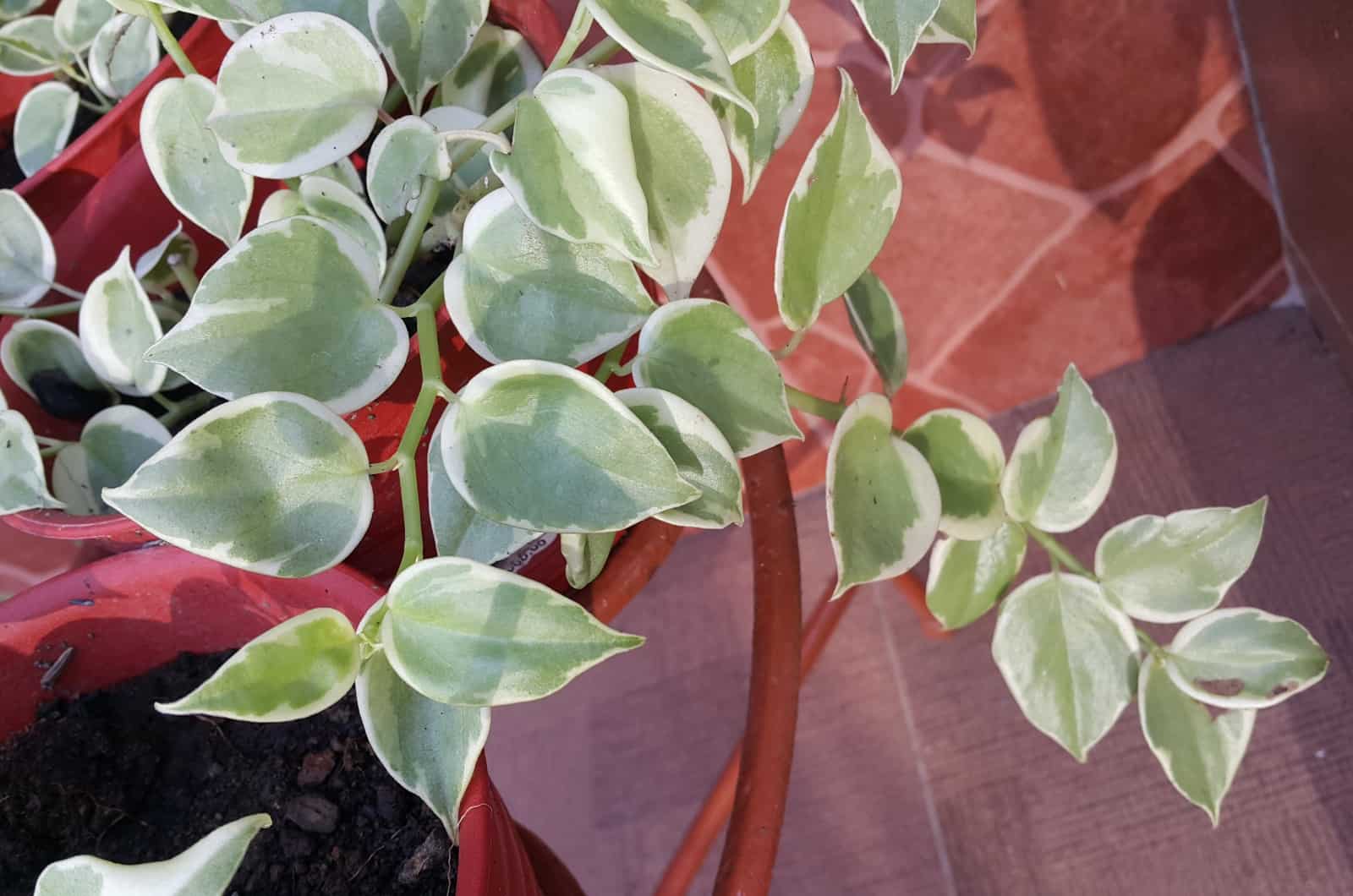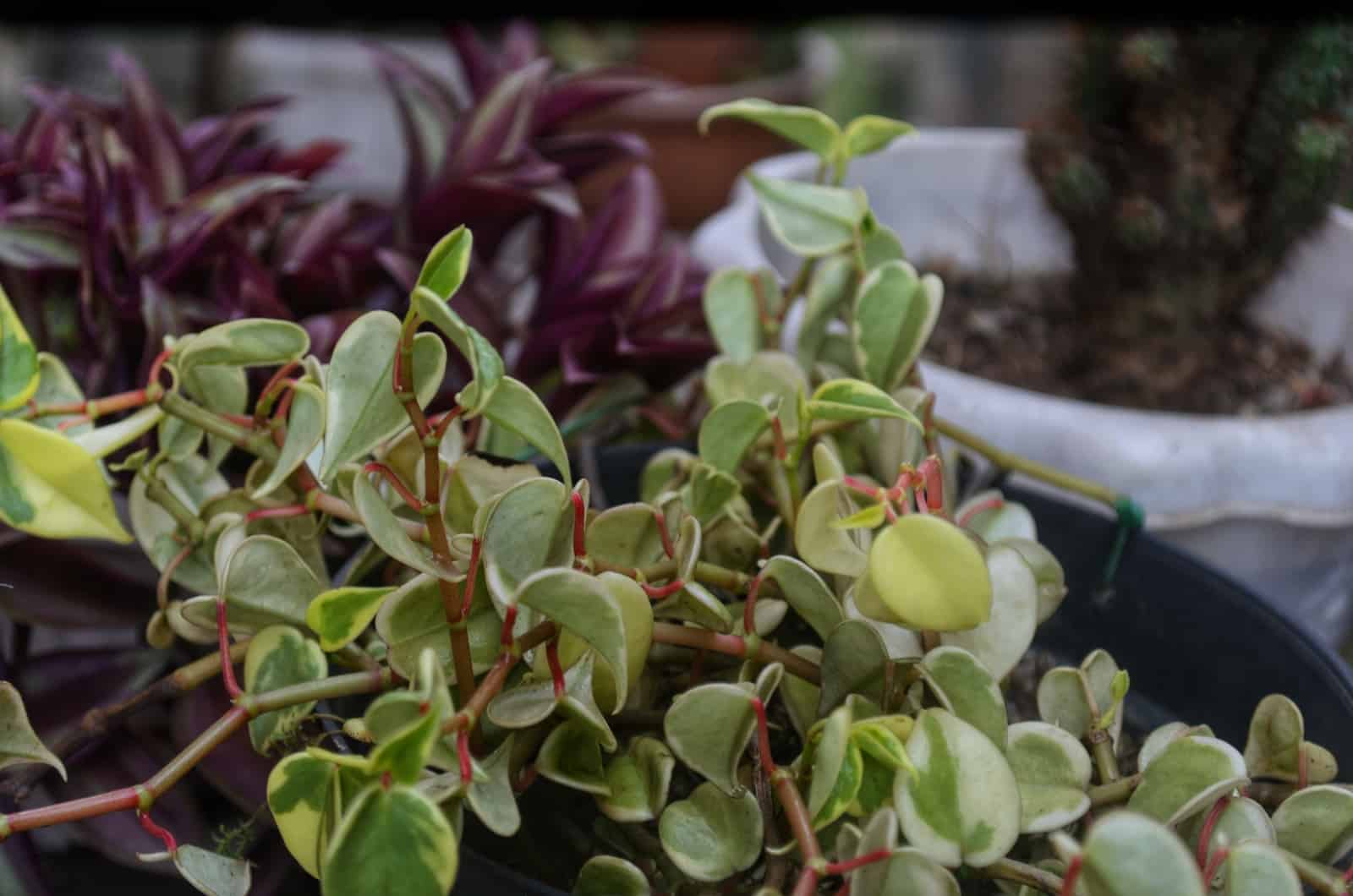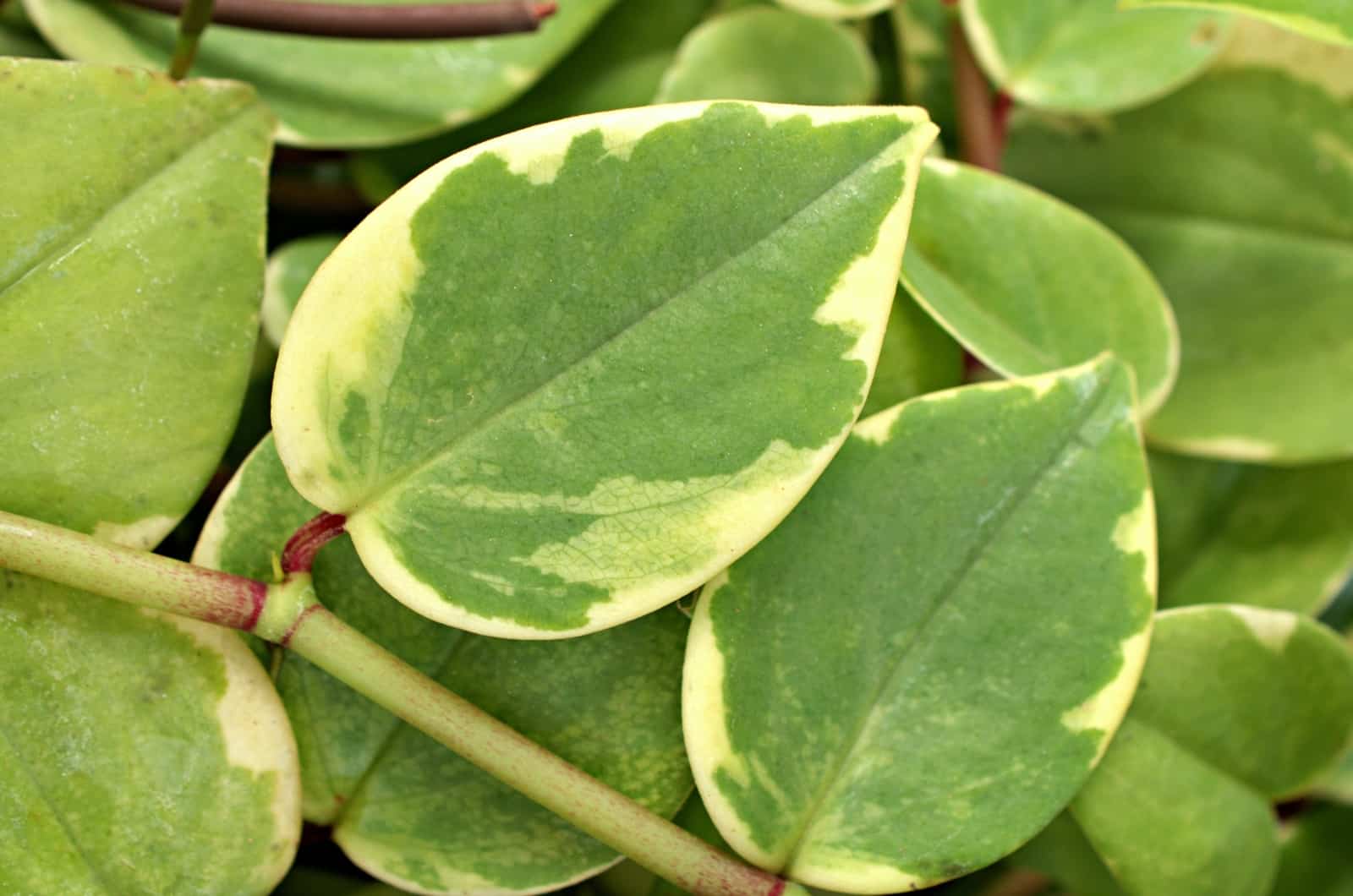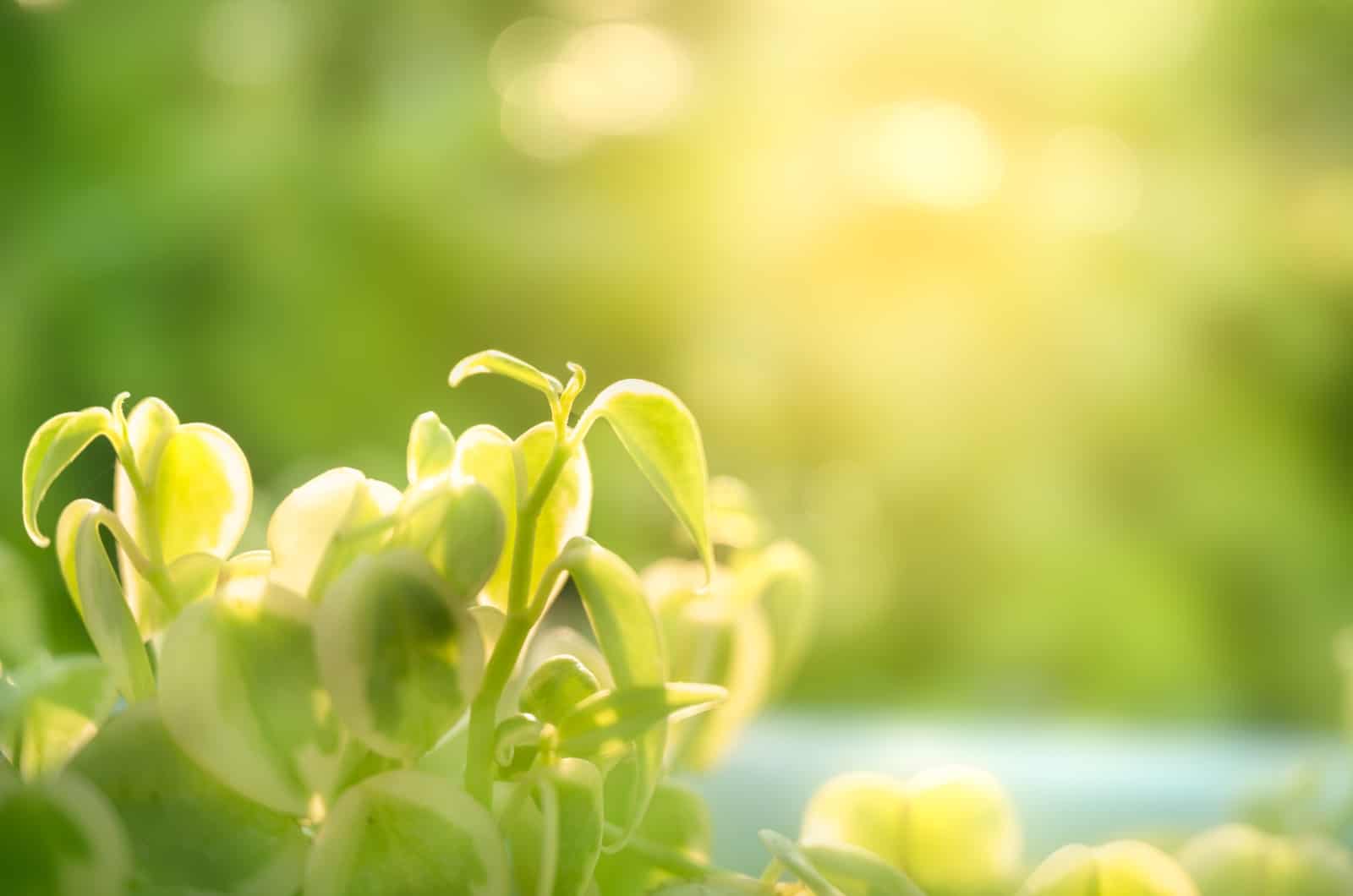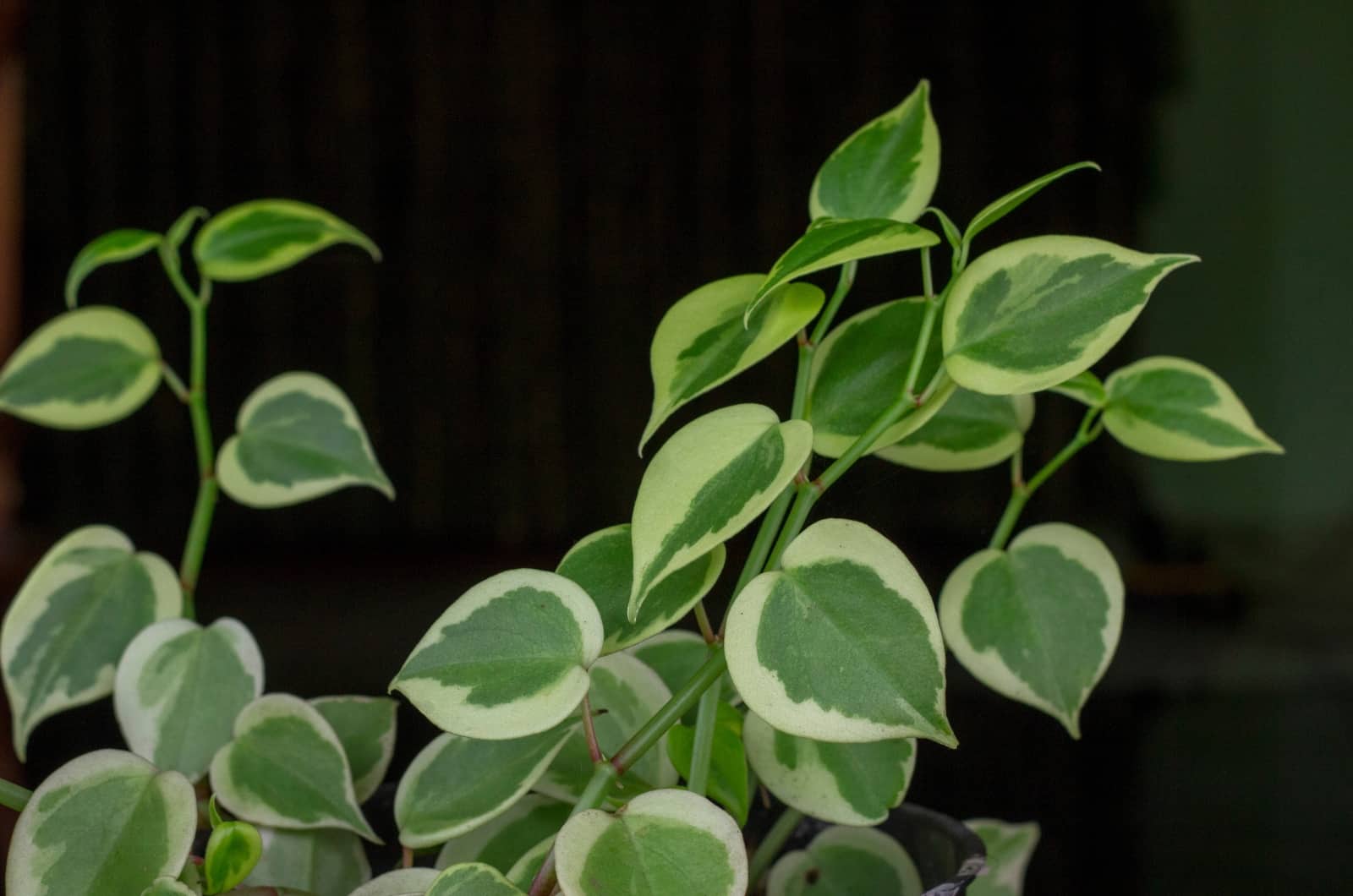Meet the Peperomia serpens, a lovely trailing plant that produces dark green, heart-shaped leaves. Peperomias are becoming more and more popular among the plant community nowadays, and for some good reasons: they look absolutely stunning and are easy to maintain.
Even a gardening beginner can grow Peperomias perfectly fine, but only if they stick to the right plant care guide.
We are going to cover the Peperomia serpens’ common features and its care guide, so stay tuned!
First, here’s some basic info about this plant:
[table id=638 /]
What Is The Peperomia Serpens?
The Peperomia serpens is a beautiful perennial plant that belongs to the Piperaceae family. These plants belong to the Peperomia genus. The name of the species is derived from the Greek words “peppers” and “homois,” which when translated mean “pepper” and “I like,” making it abundantly evident how likable these small and pretty plants are!
Origin
These plants are tropical, which means that they originate from tropical regions. Peperomia plants usually originate from the tropical regions of Central and South America.
Plant Size
This is a small Peperomia variety. It can reach up to 2 feet tall in its natural habitat, but usually grows around 1 foot tall indoors.
These tiny plants are perfect for growing indoors, especially if you don’t have a lot of space for plants.
Growth Habits
In their natural habitat, these plants are epiphytes. This means that they grow on other plants and trees. They can also crawl on the ground. When grown indoors, these plants need adequate substrate since they are not used to growing in soil.
The other name for this plant is “Vining peperomia”, which means that it produces long vines. Therefore, Peperomia serpens are perfect for growing in hanging baskets.
They are also fast-growing plants so you will be able to see those long vines in no time!
Appearance
The Peperomia serpens produces beautiful, green, and compact leaves that are shaped like a heart. Because of their compact and firm leaves, they are often confused with succulents. However, those are totally different plants.
There is also a variegated cultivar called the Peperomia serpens Variegata, though it is also known as the Peperomia scandens Variegata. This cultivar produces leaves with creamy-white variegations.
This plant does not produce flowers and it has no fragrance.
Peperomia Serpens Plant Care Guide
As we mentioned earlier, it is relatively easy to take care of this plant.
Just like any other tropical plant, it needs good drainage, warm temperatures, sufficient humidity, and some nutrients. Give them just enough water to avoid overwatering.
Keep reading to find out more!
Light Requirements
These plants are perfect for growing near an east-facing window, but what exactly does this mean?
Well, windows with eastern exposure don’t receive direct sunlight, therefore, the fragile leaves of tropical plants won’t absorb intense sun rays and suffer from sunburn.
Early in the morning, the full sun won’t harm your Peperomia serpens, and the eastern exposure will provide you more sun in the morning and indirect light in the afternoon.
Given that it receives abundant indirect light in its native habitat, keeping it near an west-facing window is also a great option.
When putting your Peperomia close to a south-facing window, either move the plant a few feet away or cover the windows with sheer curtains to screen the sun.
If you only have windows that face north, artificial lighting will be useful because a north-facing window won’t provide enough light for your little plant.
Soil Requirements
Soil requirements are especially important since these plants are not used to growing in soil. The potting soil mix must have three things: good drainage, correct pH, and necessary nutrients.
Therefore, your plant needs well-draining soil that is also fertile.
Good drainage is achieved by adding certain soil additives like perlite, but growing plants in a pot with drainage holes is also a necessity. This is because drainage holes will allow for the excess water to flow out so your plant won’t sit in soggy soil.
The right pH levels for the Peperomia serpens vary from 5.0 to 6.0, so slightly acidic to neutral.
One part perlite and one part peat moss should make up the potting mixture for your Peperomia, though you can also add orchid bark, coco coir, or grit.
Water Requirements
Peperomia plants are low maintenance because they don’t require much irrigation.
I usually water my Peperomia Ginny every 7 to 10 days. For instance, water it every 7 days in the summer and every 10 days in the winter. However, the watering needs may vary because of other growing conditions.
If the humidity is high enough, you shouldn’t need to water your plant as much.
The best thing that you can do is let the soil to dry out between waterings, however, don’t let it dry out completely. You should only check if the top few inches of the soil have dried out.
Put your finger in the soil to see if it needs watering; if it feels wet, wait until it is dry. You can also use a wooden stick; if the soil is still on the stick when you take it out, the plant doesn’t require watering. In addition to using your finger and a stick, you can also use a moisture meter.
Watering moist soil should be avoided because it will result in overwatering. Root rot might result from overwatering. This may be fatal to your plant if you don’t get rid of rotting roots.
If the soil around the plant is dry, you should give it a good watering. The dark green leaves may drop off or turn discolored along with the stem if the plant is underwatered.
If the leaves are droopy, check the soil first. In most cases, your plant is thirsty and needs watering.
Temperature Requirements
These Peperomia plants like to be nice and warm. They thrive in temperatures ranging from 68 to 75 degrees Fahrenheit.
Peperomias are not frost tolerant, which means that you will have to bring your plant indoors when the winter approaches. This also means that you should keep your plant away from cold drafts and open windows during the winter, and also far away from air conditioning and vents.
Heat sources such as radiators and fireplaces would be too hot to handle, so keep them away from those as well.
Humidity Requirements
Just like they thrive in higher temperatures, they also prefer growing in higher humidity. Luckily, these are not your typical tropical plants – they can adapt to growing in moderate humidity.
The ideal humidity levels are 40% to 50% since they can store a lot of moisture in their leaves.
To boost humidity, you can invest in a humidifier. You can also try misting your plant regularly or create a pebble tray. Be careful not to over-mist the leaves in order to prevent pathogen infections.
You can also put your Peperomia serpens in a room with higher humidity levels, such as a bathroom or kitchen.
Fertilizer Requirements
This plant is also very easy to grow because it requires little fertilizer. The plant doesn’t even need fertilizer during winter and fall since it enters dormancy.
The Peperomia serpens only needs fertilizer once a month during the growing season. There are two types of fertilizer that you can use: non-organic fertilizer and organic fertilizer.
Choose a slow-release or balanced (10-10-10) liquid fertilizer if you’re utilizing non-organic fertilizer.
Use a single application of slow-release fertilizer throughout the growing season. This type of fertilizer is usually applied at the beginning of the growing season.
Fish emulsion is a good non-organic fertilizer option. This fertilizer is widely known as fish fertilizer.
During the growing season, do not apply fertilizer too much as it can lead to overfertilization – this means that all of the chemicals and salts build up in the soil, which prevents the plant’s roots from normally absorbing the water and nutrients.
Always water the plant after feeding because it helps with nutrient absorption.
Repotting
Since these plants grow relatively quickly, you will have to repot them quite often. However, they also don’t mind staying rootbound for a bit, so if you don’t repot them every season, they will be perfectly fine.
You will also have to repot the plant if it is suffering from root rot. This is because mushy and brown roots need to be trimmed off, and the plant needs to grow in fresh soil that is not contaminated with fungus.
The Peperomia plant can adjust to its new habitat more readily in the spring, which is the best time to repot it. Remove it from its container, fill the new pot with adequate potting soil, plant your Peperomia, and then cover it with additional soil.
Take it back to its regular location after giving it a thorough watering (until you see water dripping from the drainage holes).
Pruning
Because of its rapid growth, the Peperomia serpens will also require regular pruning.
I would recommend you get rid of any damaged and discolored leaves. This way, your plant will look nice and tidy, and you will prevent spreading pests and infections.
You can also prune it to maintain a certain shape. When you keep it in a hanging basket, it will obtain a bushy appearance. You can prune it to control its growth.
Propagation
You can propagate the Peperomia serpens just as you would any other Peperomia variety. The best propagation methods include stem cuttings in water or soil.
I recently propagated my Peperomia caperata by putting stem cuttings in the water, and it has been growing like crazy!
Keep reading to see the instructions for both methods:
Stem Cuttings In Water
• Between April and August, use a sterilized knife or pruners to clip off a few good stem cuttings about 3 inches from the shoot tips.
• Trim the foliage from the lower nodes.
• Submerge cuttings with two or more nodes in water, and leave the leaves on top. To stop the spread of bacteria, you should replace the water frequently.
• Place the container in a location with good indirect light.
• Bury the roots in new potting soil 2–6 weeks after the roots have grown.
Stem Cuttings In Soil
• Take healthy stem cuttings between April and August by trimming off about 3 inches from the shoot tips with a sterilized knife or pruners. This process is the same as the one described above.
• To promote better growth, dip the stem cutting’s tip in a rooting hormone.
• Plant the cutting in a potting mixture made of two parts peat and one part coarse sand or perlite. The cutting needs to be buried in the soil about half an inch deep.
• The potting soil should now be moistened and covered with a tray designed for propagation or a polythene bag with a few holes in it.
• Set up the cutting in a room with plenty of indirect light and a temperature that doesn’t fall below or rise above 68 degrees Fahrenheit. Until the cutting needs to be replanted, make sure to uncover it every day. You can avoid excessive humidity levels in this way. If not, the plant will be vulnerable to fungal diseases.
• The plant will eventually sprout some leaves, at which point you can transplant it to a larger pot.
If you own a Watermelon peperomia, then check out this helpful article: How And When To Propagate Watermelon Peperomia
Peperomia Serpens Common Problems
Regardless of their easy plant care requirements, you may still stumble across certain issues if you don’t follow the guide closely. The most common problems are pest infestations and plant diseases, as well as inadequate growing conditions.
Let’s look closer.
Plant Disease
The Peperomia serpens is most frequently afflicted by root rot, stem rot, oedema, yellow leaves, and leaf curl. The parasite pythium is the cause of stem rot and root rot, both of which are quite dangerous.
Pythium affects Peperomias because of overwatering, and this fungal infection grows swiftly in overwatered soil.
Your Peperomia most certainly has root rot and stem rot caused by Pythium if you notice that your plant is withering and has yellowing leaves. We have already mentioned that you should repot the plant after getting rid of the affected roots.
Overwatering is the cause of oedema, which manifests as blisters or black areas. Oedema can also cause the stem to deteriorate. Optimize the drainage system and allow the soil to totally dry out before watering to prevent oedema.
Leaf Issues
Yellow leaves might appear due to inadequate plant care, including excessive temperatures, direct sunlight exposure, and overwatering.
Remember that these plants are used to growing in rainforests under tall trees, which means that they should be kept in indirect sunlight. Remove yellow leaves and move your plant somewhere else.
A lack of calcium or a pest infestation might result in leaf curl. Examine the plant thoroughly and look for any infections.
Check the pH of the soil if there are no infections. Overwatering causes the calcium level in acidic soil to drop, which results in leaf curl.
Overfertilizing is another factor that can contribute to leaf curl. Calcium will be absorbed less readily if phosphorus and nitrogen are present in higher concentrations.
Pest Infestation
Frequent pests that infest the Peperomia serpens are spider mites, mealybugs, and fungus gnats.
The undersides of the leaves will develop tiny, white or brown patches as a result of a spider mite infestation. Spray the spider mites with a solution made of alcohol and water, or use soapy water.
If your plant has any cotton-like growths, mealybugs may be present. These little white bugs are almost invisible on your plant because they are so small and white.
Rubbing alcohol and dish soap can be used to get rid of mealybugs. Use neem oil or spray the mixture on the mealybugs.
If you detect little black insects on the soil or flying around the plant, then you are probably dealing with fungus gnats.
Adult fungus gnats won’t be too troublesome. However, their larvae feed on roots and spread dangerous infections. The answer to this problem is sand and cinnamon powder. They both improve soil drainage and hinder fungus gnats from flying around.
To Sum Up
The Peperomia serpens is definitely a plant worth buying. You will end up with a lovely, small plant that produces heart-shaped green leaves. It will truly spruce up your place, and won’t even make you sweat when taking care of it!
Just make sure that these plants are warm enough and have good drainage, the rest will come through. Give it some plant food during the growing season, and water the plant when the top few inches of the soil dry.
Keep an eye out for pesky pests and annoying diseases!
That’s all, folks. I hope this article helped you.
Until next time!

